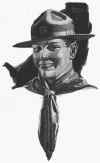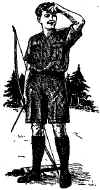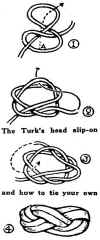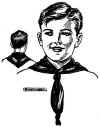By COMMODORE W E. LONGFELLOW
(AMERICAN RED CROSS
LIFE SAVING SERVICE, VETERAN SCOUT, MEMBER OF NATIONAL SEA SCOUT COMMITTEE AND NATIONAL
COUNCIL, BSA)
At Santa Barbara following the earthquake and in Illinois and Indiana during the tornado disaster, the Scout's neckerchief was a passport to any Scout through the police and hospital lines. The Scout Uniform in those stricken areas was the badge of a boy on an errand of courageous service.
James E. West, 1927
The Scouts of Old
Plains Scouts
Neckerchief Uses
The Scout's Neckerchief
How to Wear It
Why the Slide
How Sea Scouts Wear Them
Three Stranded Turk's Head
Wearing It Right
Colors
Neckerchief Duplicates for First Aid Practice
 ITHIN the past five years
the woodland tan of the Scout Uniform has been brightened by the addition of the colorful
Scout kerchief, which is now regarded as an indispensable article of equipment for every
member of the Boy Scouts of America. It is more than a part of the Scout Uniform; it is
actually one of the most useful items of a Scout's equipment.
ITHIN the past five years
the woodland tan of the Scout Uniform has been brightened by the addition of the colorful
Scout kerchief, which is now regarded as an indispensable article of equipment for every
member of the Boy Scouts of America. It is more than a part of the Scout Uniform; it is
actually one of the most useful items of a Scout's equipment.
More than sixty distinct uses have been developed for this characteristic and distinctive touch of color which has completed the outfit of the Boy Scout in America and made him one of the most picturesque figures in our national life.
The Scouts of Old
After all, the Scout of today is the legitimate heir to this bright and distinctive neckerchief which was worn by the scouts of old. The buckskin scout was obliged to dress in sober hues that would blend with the leafy coloring of the woods, the dead leaves and the earth itself. He could not afford several suits of clothes, and a new suit of buckskin was a great event in his life--not because of the difficulty in killing deer for the purpose, because that was comparatively easy, but for the trouble it was to make up a suit. Tailor shops were not common in the wilderness of those days, neither were there skilled craftsmen with the needle who could work the buckskin into a serviceable garment, so one suit of clothes had to do a long time.
Whatever his love of bright color, the woods-running scout was a hunter of animals, or birds, or men, who was in turn hunted by his enemies, and so was obliged to forego this color while in the forest. The less conspicuous his garb, the better bag of game and the safer his hair rested upon his head. But when he came to a settlement, seeking relaxation, there was no need for restraint in the matter of color, and so, by means of a crimson scarf to tie his long hair, or a purple or blue sash, he was able to satisfy this yearning for bright things.
On those occasions when a woods runner was visiting a settlement wearing his bright scarf, it was quite clear that he was resting from the trail and seeking relaxation; he was wearing his best and was on parade, willing to be reviewed by the finest people in town. On the trail, his scarf or kerchief took up but little room in his meager bag; moreover, in case of a wound it had great possibilities. The Scout of today is heir to the many worthwhile things of that earlier forest runner who could shift for himself under the most difficult circumstances.
Plains Scouts
In later days, when it became necessary to settle the great plains and blaze the trails for the railroad, the telegraph and the broad highroads of today, a sturdy breed of plains scouts came into existence to guide and guard the workers and hunt and trap for them to provide food. These plains scouts rode horseback, and as their ponies kicked up the sand and dust, some of it filled with alkali, it made breathing difficult, so that in defense they wore around their necks a broad kerchief. Whatever the color of their work-a-day kerchiefs, and however drab they might be if Indian wars were under way, even the poorest of them could carry a bright red, blue, green or yellow scarf for dress up occasions. So from this scout too today we inherit the bright neckerchief.
Neckerchief Uses
In those days these neckerchiefs were worn with the broad point to the front and were loosely knotted behind the head; thus it was possible, in case the dust became very bad, to tighten it over the mouth and nose and use it as a filter against the dust and as a protection against the blinding sand storms which sometimes bothered travelers on the wide expanses of the great western basins.
To be sure, many of the lawless bandits that infested the plains in those perilous times used the neckerchief as a facial disguise, and it proved effective because most men looked alike as to their outer garments, with wide felt hats, flannel shirts and overalls or "chaps" of the plains rider.
So the Scout of today uses his neckerchief soaked in water to filter the fire from heat-laden air and to cool smoke when entering a burning building as he crawls along the floor in the only strata of fresh air left. The Scout of today knows that it is not a gas mask, but merely a smoke screen and filter.
The Man O'Warsmen of old originally wore the neckerchief as a mourning badge after the death of Lord Nelson. This British Naval hero was revered on both sides of the water, and by the time the American Navy was separated from the British Navy and in conflict with it, it was natural enough to continue. to use this folded square of black silk as a part of the sea-going uniform of the mariner fighting under orders of the Continental Congress.
Made as it is of tough silk of very light weight, this kerchief has been found to be of great value as a first aid appliance to stop hemorrhage, sling a fractured arm or bind up a broken head. And so its continued use in the modern Naval uniform has the sup port of both tradition and custom, and of the medical authorities who see in it a first aid appliance of the very highest efficiency and greatest utility.
In view of these facts, it is clearly no exaggeration to say that the neckerchief is one of the most characteristic and distinctive parts of the uniform of a Scout. It identifies the district to which he belongs; by the knot in the end it reminds him of his Daily Good Turn; it reminds him that he is a Scout with traditions to sustain, and every time he adjusts it on his neck he is challenged to devise more and better uses for it.
The Scout's Neckerchief
Up to about 1915 the neckerchief was not generally recognized as a necessary part of the Scout equipment, and a number of Scout enthusiasts were asked for ideas on possible uses of the neckerchief. I was already much in favor of it and could think of as many as eighteen Scout uses for it at that time. This appeared to be about twelve more than anybody else could think of, so I was selected to write an article on the neckerchief, and by the time I completed it I developed some twenty-eight uses. These soon grew to thirty, and now we have more than sixty uses to recommend to Scouts the world over. Whole Scout demonstrations can be given with the help of the neckerchiefs worn by members of the Troop, but after all, the best demonstration is the actual utility, and we will endeavor to confine our description to the actual rather than the theoretical uses of the neckerchief.
How to Wear It
Here is the proper way for a Scout to fold and wear his neckerchief.

Method of folding the Scout Neckerchief,
the number of cross-folds--if any--
governed
by the size of the Scout, in order to assure
smooth set at back. The
half-neckerchief,
when used, takes same cross folds.
First, fold the neckerchief once to get the triangle. According to the size of the boy, turn the long edge over about three inches, smoothly once or, twice, or even three times, to insure the neckerchief lying smoothly at the back and hanging correctly in front.

The correct form in wearing
the Scout Neckerchief, with
Turk's head slip-on and
Good Turn knot at bottom.
Place around the neck over the collar of the shirt, insert the slide up over the ends to the point where the knot would be if tied as a four-in-hand necktie. Then tie the two loose ends in an overhand knot, as if it were one piece of material. This lower knot is a constant reminder of the Daily Good Turn. The illustration clearly shows the finished effect.
Why the Slide
The advantages of the slide are that in hot weather and, on the hike the neckerchief can be loosened around the throat, while in a cold wind or snowstorm it can be drawn closer to serve as a muffler. When necessary to use the neckerchief, in emergencies, the slide can be instantly drawn down, permitting the neckerchief to be whipped off over the head.
When the slide is not used a knot must be tied, and it is seldom tied twice alike. nor at the same position at the 'throat, a very untidy appearance resulting. The slide is an immense convenience and adds distinctly to the appearance of the neckerchief.
How Sea Scouts Wear Them
It will be noted that the Sea Scout method of wearing the neckerchief differs from the method used in shore Scouting. The sea going Scout will prepare his kerchief as do the sailors in the Navy, finishing with a flat knot on the tails. This type of neckerchief does not look well unless covered by a wide collar; consequently it is not used with the khaki uniform but only with the sailor collar.
In connection with the preparation of your own Turk's head knot for a home made slip on, the Sea Scout Manual gives a description of the way to make a Turk's head, as follows:
Three Stranded Turk's Head
Take two round turns around the rope on which you intend working the knot, or around the index finger of your left hand. Pass the upper bight down through the lower, and reeve the upper end down through it; then pass the bight up again, and reeve the end over the lower bight and up between it and the upper one; dip the upper down through the lower bight again, reeve the end down over what is now the upper bight, and between it and the lower; and so proceed, working round to your right until you meet the other end, when you pass through the same bight, and follow the other end round and round until you have completed a plait of two, three or more lays, along the three strands of the Turk's head.
Wearing It Right
James E. West, Chief Scout Executive, says "We are anxious to have the co-operation of every Scout and Scout Official in making effective the regulations covering the Official Uniform, Insignia and Badges. To tolerate a conscious disregard for requirements, even in simple matters, breeds disrespect for law and order.
"When I have found boys wearing the neckerchief, under instead of over the shirt collar, it developed that invariably the Scouts, and indeed their own Scoutmaster, did not understand the correct way of wearing the neckerchief. I am anxious that every Scout and Scout Official study the diagram, wear the neckerchief in the right way, and that he invite the attention of other fellows to the right way, when he finds them wearing it wrong."
Colors
The color of the neckerchief indicates the Troop, District or Council, according to the local regulations. Scout neckerchiefs should always be worn with a contrasting slide which in appearance resembles the Turk's head knot and serves as a reminder of the Scout's Daily Good Turn pledge.

Neckerchief and Slide.
The main reason that this slide is used rather than a knot is that it permits the neckerchief's instant removal if needed in an emergency. Slides, are furnished by Headquarters in variety of colors, and when once adopted each Troop should stick to the color and have it, worn by all members. There, are many varieties of slides, however, and characteristic slides are often used such as the Kukui nut in Hawaii, and the Horn slide or sheep vertebra slide of the western plains.

Slip-ons made from wood or bone.
Practically all of the uses of the neckerchief are because of its triangular form, so that a triangular bandage can be used for practice, thus saving the official color kerchief so that it makes a good appearance on the uniform. It should be borne in mind, however, that the Official Neckerchief is slightly smaller in size than the regulation triangular bandage which is made by splitting a yard of square piece of cloth, crosswise.
Neckerchief Duplicates for First Aid Practice
In order to be sure that the rehearsed uses of the neckerchief are applicable to the regulation scarf, it might be well to make a duplicate of the regulation scarf in white cotton cloth of the exact Scout dimensions, 32 x 32 inches, and use it for all, practice purposes.







